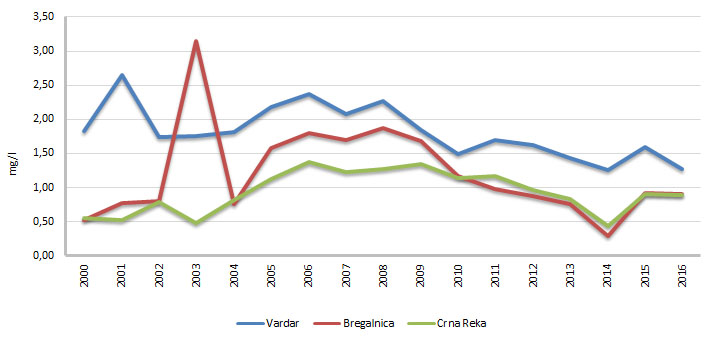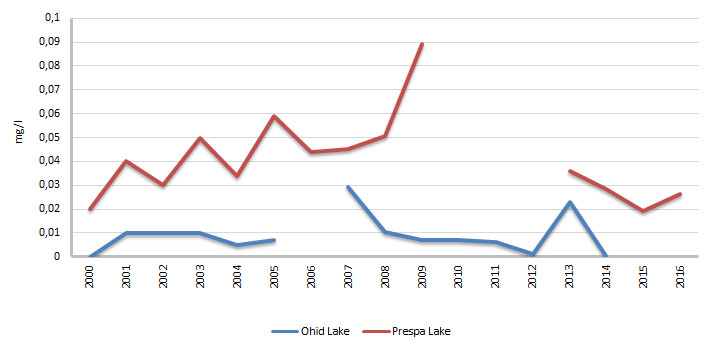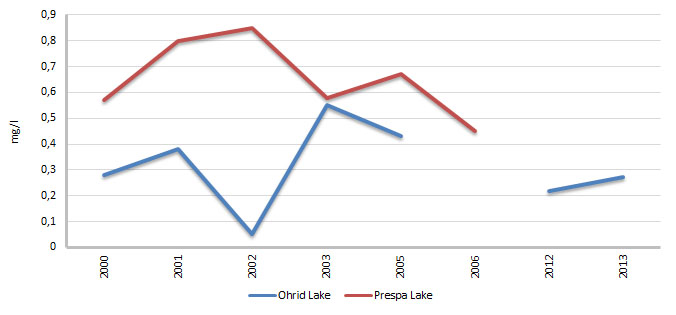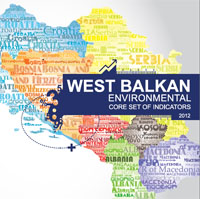| NUTRIENTS IN FRESHWATER |
- Concentration of nitrate is expressed as mg nitrate (NO3)/l, and orthophosphate and total phosphorus as mgP/l.
Has the nutrients concentration in water courses shown rising trend?
Despite of the absence of continuous monitoring of the status of groundwaters quality in the Republic of Macedoniaduring the last years, it can be stated that the concentration of nitrates in drinking water has been in a stable ecological health status.
In the analyzed period, slight drop was recorded in the mean annual concentrations of nitrates and orthophosphates in all three rivers. An exception was recorded in the period from 2013 to 2016, when insignificant increase in orthophosphates concentrations was recorded in all three rivers.
Throughout the investigation period, the Lake of Ohrid has sustained its oligotrophic nature as shown on the Table on the concentrations of phosphorus and nitrates. Significantly higher concentration was found in the waters of the Lake of Prespa, thus increasing the risk of Lake’s water eutrophication.
Figure 1. Nitrates and orthophosphates in rivers
 Figure2. Nitrates in rivers by river
Figure2. Nitrates in rivers by river
 Figure3. Orthophosphates in rivers by river
Figure3. Orthophosphates in rivers by river
 Figure 4. Total phosphorous in lakes
Figure 4. Total phosphorous in lakes
 Figure 5. Total nitrate in lakes
Figure 5. Total nitrate in lakes
 Data coverage: excel
Data coverage: excel
Source: MEPP, HMA, HBI
https://arhiva.moepp.gov.mk/?lang=en
Annual mean concentrations of nitrates and orthophosphates have remained relatively stable since the beginning of 1990’s. It has been found out that the concentration of these parameters is higher at certain measuring points of VardarRiver.
Analysis of the results from the measurements in the plagial parts of Ohrid Lake throughout the period has confirmed the oligotrophic nature with relatively stable concentrations of phosphorus (below 0.015 mg./l), with higher concentrations of phosphorous (0.030 mg/l)recorded in 2007 in Ohrid Lake and nitrates concentrations within permissible limits (mean annual concentrations below 0.55 mg/l). From 2013 until 2016, investigations were carried out in Prespa Lake’s litoral and pelagial zones, where the concentrations of nitrates and total phosphorous were noted as declining. It is important to note that in the period from 2014 until 2016, there is no available data on nitrates and total phosphorous in the Ohrid Lake. Concentrations are significantly higher in Prespa Lake, where organic compounds are found at high levels, thus increasing the risk of the Lake’s water eutrophication.
- Methodology for the indicator calculation
The calculation of the indicator is based on the methodology established under Eurowaternet, established by the European Topic Centre for waters of the European Environmental Agency.
Under this process, the manner of selection of monitoring stations is defined and the type of monitoring parameters and the frequency of their collection are specified.
List of relevant policy documents:
The National Environmental Action Plan – 2 and the Environmental Monitoring Strategy and Environmental Data Management Strategy.
Strategy for Waters has been developed in order to establish long-term policy that will secure sustainable development of waters by meeting the demands of all water users, protecting waters against pollution and providing pollution control.
The Law on Waters transposing the following EU Directives into the national legislation:
- Framework Water Directive (FWD) 2000/60/ЕЕC, according to which, by the year of 2015, rivers in EU should achieve good ecological status or good ecological potential.
- Directive on nitrates (91/676/ЕЕC), the goal of which is to reduce nitrates and pollution by organic matter originating from agricultural lands.
- Directive on urban wastewater treatment (91/271/ЕЕC) aimed at reducing the pollution from sewerage and industrial wastewater treatment plants
The Law on Environment has transposed the Directive on Industrial Pollution Prevention and Control (IPPC) 96/61/ЕЕC is aimed at control and prevention of water resources pollution by industry.
Legal grounds
The Law on Waters prescribes the main planning documents for water protection, maintenance and permanent improvement of available water resources and sustainable use of available water quantities.
The main planning documents for water management planning and development include:
- The National Strategy for Waters
- Water Management Master Plan of the Republic of Macedonia, and
- River basin management plans.
For the purpose of maintenance and improvement of the quality of water and establishment of the adequacy of water for use for different purposes, the Law on Waters specifies classification of waters and categorization of water bodies, as well as specification of deadline for achievement of the water quality goals for each water category and specification of the minimum standards for water quality and environmental protection goals for all water bodies. Such plans contain environmental protection objectives in order to achieve good status of surface water bodies (good quantitative and chemical status, including also good ecological potential) and ground water resources (good quantitative status and chemical status).
The Decree on categorization of water courses, lakes, accumulations and water resources (1999) specifies the quality of water by specific classes of water in water bodies, lakes, accumulations and groundwater resources. This Decree also establishes five categories of water courses
Under the Law on Waters, authorities responsible for health protection are obliged to carry out monitoring of waters intended for human consumption and bathing waters, and for undertaking measures for active protection of the population against communicable diseases of high social and health relevance. The competent institutes perform microbiological parasitological, hygienic, toxicological and biochemical analyses within the scope of their activity.
Programme for preventive health protection performs monitoring over the quality of surface waters at all points of health interest, in order to enable timely undertaking of measures for population protection. Waters used as drinking water sources, sports and recreation and primary agricultural production are of highest interest.
The indicator is not related directly to the requirements of a single Directive. Ecological quality of surface water requiring reduction of eutrophication and nutrient concentrations is a target specified in several Directives, namely:
- Directive on drinking water (98/83/ЕC) – maximum permissible concentration of nitrates is 50 mg/l;
- Directive on abstraction of surface water intended for drinking (75/440/ЕЕC) requires nitrates concentration of 25 mg/l.
- Directive on nitrates (91/676/ЕЕC) requires identification of groundwater bodies where the annual concentration exceeds or may exceed 50 mg/lnitrates.
- Directive on urban wastewater treatment (91/71/ЕЕC) specifies reduction of the pollution caused by organic matter as its objective.
- ЕЕА
| Code | Title of the indicator | Compliance with CSI/ЕЕАor other indicators | Classification by DPSIR | Type | Linkage with area | Frequency of publication | |
| MKNI 020 | Nutrients in freshwaters | CSI 020 | Nutrients in freshwater | S | A | Water | Annually |





































































